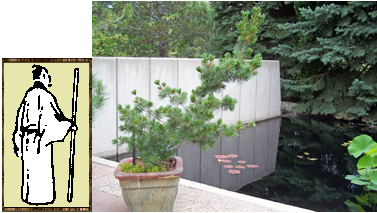
Hexagram Thirty-four—Maturity
Hexagram Thirty-four shows justice and right action prevailing over might. In this case, strength will only succeed if it is on the side of good.
The first line, yang, shows one's strength concentrated in the feet, for motion, rather than in the head and heart, for intelligence. The person is unbalanced and going forward will lead to misfortune.
The second line, yang, shows that after realigning one's strength, going forward will bring about the desired result.
The third line, yang, shows a ram butting its horns into a fence and getting stuck. Gaining power and wealth, immature human beings will ruin themselves with their own might. Witnessing such a demonstration, cultured people simply leave the scene to avoid becoming entangled.
The subject of the fourth line, yang, opens the gate, thus the ram passes through without becoming entangled. Using intelligence, wise people succeed without making an angry demonstration.
The fifth line, yin, shows that the intelligent sometimes become unduly angry, but they rise above it soon enough. There is no blame for a slight deviation.
The sixth line, yin, shows the ram butting into the fence and getting stuck. If the ram would only learn from this experience, then it would stop getting itself stuck. Might will not conquer where intelligence is required.
Hexagram Thirty-four Commentary
This hexagram takes a stand for the strength of justice. Although it is easy enough to become cynical and say justice is lost to the world and only might has power. It may be so at times, but this hexagram addresses those situations where justice prevails. The introduction says, "In this case, strength will only succeed if it is on the side of good."
The first line, yang, explains the imbalance of the subject letting feet make the decisions. Although it is the feet that walk, strength of purpose must come from the head and heart.
The second line, yang, comments on the predicament of the first line. Once the subject realigns to put the head and heart in control, going forward works better.
The third line, yang, offers the metaphor of a ram that gets its horns stuck in a fence. The interpretation offered in this line is of immature people who ruin themselves because they let wealth and power control their minds. Further, the line says better people will simply leave the scene to avoid getting pulled into it.
The fourth line, yang, shows its subject simply open the gate so the ram can pass through. The meaning is emotionally mature people express themselves clearly. They are not interested in destroying themselves through unnecessary anger and drama.
The fifth line, yin, is an example of an intelligent person who becomes angry, who may try to push through a situation with might, instead of intelligence. Although this may occasionally happen, intelligent people will get hold of themselves soon enough, and go back to using their intelligence to solve problems. Because this happens occasionally, the line says, "There is no blame for a slight deviation." Nowadays we might say: everybody hits the wall sometimes.
The sixth line, yin, shows the ram who uses its brute force to butt into the fence again and get stuck again. Any situation where intelligence is required, such as times we need to learn from mistakes, is absolute proof might does not make right. The line concludes, "Might will not conquer where intelligence is required."
To the reader: Most of the hexagrams have at least one line that predicts bad results, but that does NOT mean you are fated to that result. The hexagrams illustrate different attitudes, so study the actions and reactions to learn the attitudes that will lead to better outcomes.
The I Ching teaches you to flow with changes and create positive change from the inside through conscious living. Your future is in your hands. Consult the I Ching for ideas that lead to clear thinking and positive mental attitude. Reading the I Ching helps you take the time to reflect on your attitudes and ideas. Continue asking until you feel positive about your course.

Click here for another hexagram.
A note about this interpretation of the I Ching: Nori Muster wrote this version of the I Ching in 1994 and put it online at Surrealist.org in 2000. It is also available at Amazon:
e-book
paperback
